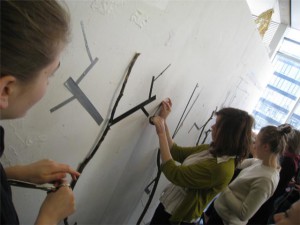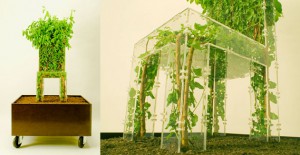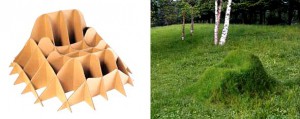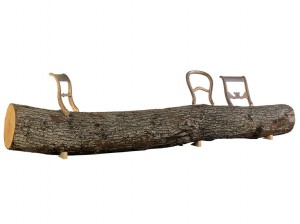Growing your own design-chair, made out of living trees, grass or crystals – sounds interesting?
Nowadays, more and more designers are working with nature, instead of against it. They’re combining unpredictable, living objects with well-thought design and come up with new ways to make creative and durable furniture.
In a workshop, given by graphic designer Ayumi Higuchi, students had to create trees out of black tape. Every student received one role of tape and together they had to make a tree on the wall. It was interesting to see how this worked out – you’re able to control your own decisions, how and where to place the tape on the wall, but you can never completely control what the others will do with their roll.
This concept – not being able to direct the final outcome of a project- is closely related to the trend of ‘growing designs’. One could speak of an ‘eco-trend’, a form of slow design in the furniture-industry. In recent years, more and more designers experiment with the combination of nature, and the natural forms it grows in, together with practical and smart designs. We can see this most clearly in the design of chairs. Chairs that mingle the, in a way, unpredictable side of nature with the well-thought side of modern furniture design.
Just like with the trees made of tape, designers are using elements in their work that they can never fully control – and they do this on purpose, because it makes the outcome more interesting. One can only predict the way the final work will look like. And, commercially speaking, it’s a smart way of working. In the IKEA-era, a time in which identical chairs can be bought for just a few euro’s, buyers are now looking for more unique, durable designs – they don’t want to see how the chair they just bought is also to be found in the living room of their neighboor.
Below, you’ll find some interesting projects that illustrate this new design-trend. All working very differently, they still show simular starting points.
First, there’s the work of Christopher Cattle that really shows the concept of taking the time to make an object, being very aware of the process of designing and being able to constantly make small changes in this process, to try to change the outcome. In this case it’s the use of growing trees, to make a small stool. The making of one can take about 5-7 years and you can make it bigger, stronger and higher by working together with the growing process of the tree itself. As you see on the image, the stool is made from three sycamore saplings that are ‘trained’ and grafted together around a plywood jig to form the tripod base of the chair. In an interview, Cattle points out:
‘Growing furniture […] can be used to demonstrate that it is possible to create genuinely useful things without adding to the pollution that industry inevitably seems to produce. Trees are self-generating […] It’s free and it’s non-polluting. Training and grafting trees as they grow are established traditional crafts, and wood is durable but it’s also biodegradable, so it doesn’t have to end up in a hole in the ground. I call this Grownup furniture as it’s the result of mature thinking.’
Another project in which a designer is working with nature, is the ‘Venus Chair’ by Tokujin Yoshioka‘s. This chair might not be that comfortable, it is a nice concept in which design and nature can get along. The object is made from growing natural crystals.
The Venus Chair is grown in a tank, the production process is half controlled by Yoshioka and half left up to nature, therefore giving space for interesting developments in the work. Yoshioka says: “I […] feel that incorporating the principles and movements of nature into ideas will become something important in future design.”
This is a prototype of his crystal-chair.
A work that is ready to use, is the design developed by Michel Bussien. It’s called the ‘Growing Chair’. It’s potted and on rollers, but you can of course remove the box and put it in your garden. A nice see-through chair, a very good example of letting nature, literally, fill up the design. To use the complexity and beauty of natural forms and include this in new designs – to almost ‘reconstruct’ nature, without having to bend and force the natural shapes in a dramatic way.
Also great for your back garden is ‘The Grass Armchair’, by Purves & Purves. Again, working with a frame, this chair is ‘leading’ the grass. It will almost dissapear in the landscape, being completely covered up with the surroundings, you’ll have to be careful while mowing.
The chair is made of biodegradable cardboard which you fill with gravel and soil, seed with grass.
Finally, this last example is made by the Dutch ‘Droog Design’. It’s the so-called‘Tree-trunk bench’ by Jurgen Bey. In his design ‘A fallen tree can serve as a seat. The addition of bronze classical chair backs makes it a proper piece of furniture, a crossing between nature and culture.’
The designer makes clear, very firmly, that ‘it is ridiculous to transport trees when they are locally available.’
It is because of this statement that only the chair backs are for sale, thereby forcing the buyers to really find a tree, that’s already there, to use. Thereby making the buyer very active in the process of the design. Although this tree is not growing anymore, it’s still a nice way of using natural shapes and transforming it into a design.
All these projects show how you can make unique design in a new, eco-friendly way. A ‘movement’ that will probably set the trend for future designs and will constantly inspire designers to work in a creative way with what’s already there.





